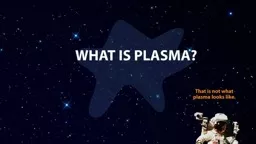

ie ignoring dark matterenergy Lets do that Our universe likely contains more than 100 billion galaxies and each of those galaxies may have more than 100 billion stars Stars in the heavens may also appear to be different colors because their temperatures are not all the same Hot sta ID: 631834
Download Presentation The PPT/PDF document "~99.9 % of the observable universe" is the property of its rightful owner. Permission is granted to download and print the materials on this web site for personal, non-commercial use only, and to display it on your personal computer provided you do not modify the materials and that you retain all copyright notices contained in the materials. By downloading content from our website, you accept the terms of this agreement.
Slide1Slide2
~99.9 % of the observable universe
i.e. ignoring dark matter/energy Let’s do thatSlide3
Our
universe likely contains more than 100 billion galaxies, and each of those galaxies may have more than 100 billion stars.
Stars in the heavens may also appear to be different colors because their temperatures are not all the same. Hot stars are white or blue, whereas cooler stars appear to have orange or red hues.Slide4
Whoosh!Slide5
Discovered on 5 September 1784 by astronomer William Herschel, the Veil Nebula was once a star. Now it is a twisted mass of shock waves that appears six times larger than the full Moon in the sky
.This Hubble Space Telescope image shows just a small part of the nebula, a region known as the 'south-eastern knot'. The entire nebula is about 50 light years in radius, and is located almost 1500 light years away
.
In
this image, blue shows oxygen, green shows
sulphur
, and red shows hydrogen
.
Supernova explosions are important because they seed the Universe with heavy chemicals, building all the elements heavier than iron. They are rare in our galaxy, with only one or two stars exploding over the course of a century.Slide6Slide7
+ EnergySlide8
The “4th State of matter”?
“Plasma is a (hot and diffuse) ionised gas”?Best to describe plasma as a “behaviour”Collective
behaviour
s.t.
dynamics dominated by Electromagnetic forcesSlide9
Something silly, wrong and immediately contradictory that someone said on Stack ExchangeSlide10
QuasineutralitySlide11
https://www.youtube.com/watch?v=6VdMp46ZIL8
What gases do.
Kinetic theory of Collisional Fluid/Gas dynamicsSlide12Slide13
Guess the mean free path!!
Vacuum range
Molecules/cm^3
Mean free path
Ambient pressure
10^19
Low vacuum
10^16
Medium
vacuum
10^13
Millimetres
10^-3
High vacuum
10^9
Metres
Ultra-high vacuum
10^4
Extremely
high vacuum
<10^4
> 100
megametres
10^8
Vacuum range
Molecules/cm^3
Mean free path
Ambient pressure
10^19
Nanometres
10^-9
Low vacuum10^16Medium vacuum10^13Millimetres 10^-3High vacuum10^9Metres Ultra-high vacuum10^4Extremely high vacuum<10^4> 100 megametres 10^8
Vacuum rangeMolecules/cm^3Mean free pathAmbient pressure10^19Nanometres 10^-9Low vacuum10^16Micrometers 10^-6Medium vacuum10^13Millimetres 10^-3High vacuum10^9Metres Ultra-high vacuum10^4Extremely high vacuum<10^4> 100 megametres 10^8
Vacuum range
Molecules/cm^3
Mean free path
Ambient pressure
10^19
Nanometres
10^-9
Low vacuum
10^16
Micrometers 10^-6
Medium
vacuum
10^13
Millimetres
10^-3
High vacuum
10^9
Metres
Ultra-high vacuum
10^4
Megametres
10^6
Extremely
high vacuum
<10^4
> 100
megametres
10^8Slide14
Collisionless plasmas
Most of the universe is plasmaMost of the universe is collisionless-> Most of the universe is collisionless plasmasI study equilibria of
collisionless
plasmas
https://
www.youtube.com
/embed/hOqIykmJNJ8